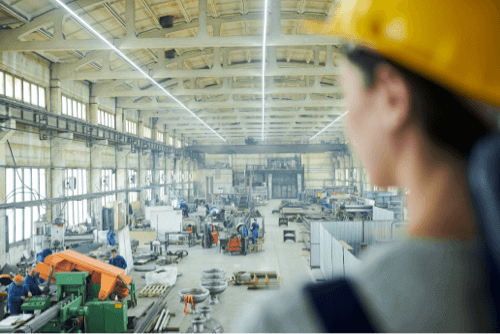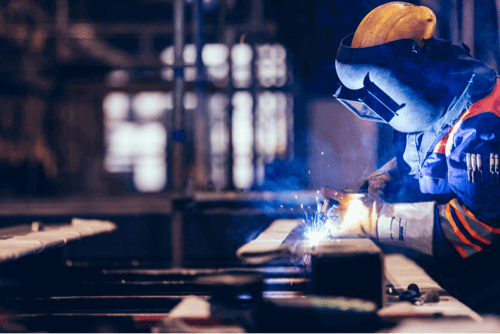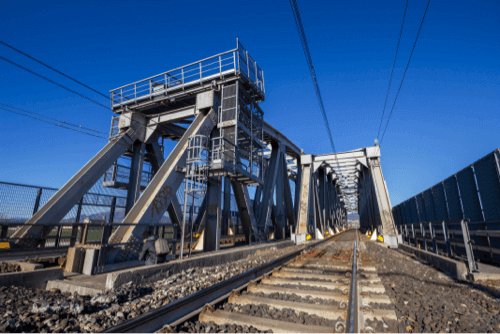
The steel industry is a very important part of the national economy. Despite being a branch present in several Brazilian states, the concentration of the steel industry in Minas Gerais stands out.Before explaining the current situation of the mining industry, let's understand what the steel industry itself is and how the railways are directly linked to this industrial process.
The steel industry is a branch of metallurgy specifically responsible for the manufacture of steel and cast iron. Like any sector that involves production, the steel industry depends on transport routes so that a efficient product flow.
In Brazil, because of a history of investments destined to the construction of roads, road transport is one of the main means used in the transport of loads. However, mainly in the steel sector, the rail modal can be a more efficient way of transporting the sector's inputs.
Uma das principais razões para isso é que muitas etapas da produção siderúrgica exigem o transporte de grandes volumes de carga. Primeiramente, os minérios devem ser levados dos locais de extração para as usinas. Depois disso, os produtos finais devem ser entregues aos compradores, sendo que isso envolve o transporte para outras regiões do país ou zonas portuárias para a exportação.
Freight trains are capable of transporting large amounts of inputs, which results in fewer trips required compared to road transport. In addition, for medium and long-distance journeys, rail trips are faster,contributing to a more efficient logistics process.
Next, we will understand the current situation of the steel mills in Minas Gerais and the main railways involved in the sector.
Content Index
Overview of the steel industry in Minas Gerais

Due to its territorial extension and large reserve of resources, Minas Gerais played an important role in the steel industry, from the first steps of the sector until the beginning of the 20th century. One of the Brazilian steel companies was installed today in the state of Minas Gerais: Companhia Siderúrgica Belgo-Mineiranowadays called ArcelorMittal Açosos.
Another highlight was the creation of Companhia Siderúrgica Nacional (CSN) in 1941.The plant was part of the strategy promoted by Getúlio Vargas to promote the country's economic development with basic industries. Although its initial headquarters were in Volta Redonda (RJ), its main iron mines were in Congonhas and Arcos, both in Minas Gerais.
Currently, the state of Minas Gerais also has other plants in the sector. The main companies that are part of the steel industry in Minas Gerais are Gerdaufounded in 1901, Aperam South Americain 1944 and Usiminasin 1956.
Total steel production in Minas Gerais is the largest in the country. According to data from Instituto Aço Brasil, in 2019, the state produced about 10.4 million tons,which corresponds to 32.3% of the Brazilian total..
Main railways serving the steel industry in Minas Gerais

As stated in the introduction to this article, the steel industry requires transport routes for an efficient flow of products.
One of the main ferrovias de Minas Gerais is the Vitória-Minas railroadHaving been founded, this line connects 1904 (MG), passing through several cities in Minas Gerais. Operated by Vale S.A. and with an extension of 905 km, one of its most important functions is to carry the steel production from Minas to the ports of Vitória and Tubarão (ES).
Another road is the Ferrovia Centro-Atlântica As one of the largest rail networks in Brazil, with around 7,000 km of tracks, it connects more than 300 cities in the Southeast, Midwest and Northeast.
Brazilian Southeast Regional Network is also one of the most important sets of lines in Minas Gerais. Operated by MRS Logística S/A, it passes through several regions of the state of Minas Gerais, in addition to connecting municipalities in Rio de Janeiro and São Paulo, enabling transport to the Port of Santos (SP).
Modernization of the sector

Like most work sectors, the steel industry must also undergo modernization. To this end, some measures are being taken to not only take advantage of new technologies,but also to improve the sector's environmental responsibility. o.
Gerdau, which is one of the main figures in the steel industry in Minas Gerais, proposed in August an investment plan with modernization strategies.
One of the strategies is the application of digital tools that optimize water and energy costs.Similarly, the company plans to replace waste emission control equipment in the steelmaking process.
In addition, the investments will be used to increase its eucalyptus forests. This will increase the production of charcoal that will replace coal, a great enemy of the environment.
These solutions to the construction of new railways, which must also undergo innovativecan contribute so much to the construction of environmental damage.
future investments

As a way of encouraging investments in the railway sector, a bill called Marco Legal das FerroviasIts main purpose is to simplify the authorization process for the construction of railways, facilitating investment by private companies.The Senate already approved it in October. Currently, the project is being analyzed in the Chamber of Deputies.
Although not fully approved, other similar measures are already emerging. Created based on the Legal Framework for Railways, the Pró Trilhos program is a government initiative to boost the construction of new railways based on private investment.At the beginning of December, the Ministry of Infrastructure approved the authorization of the document that allows the beginning of the works. Investments total around R$ 50 billion to add 3,500 km to the national rail network.
The agreement was signed by six groups: Bracell, Ferroeste, Grão Pará, Macro Desenvolvimento, Petrocity and Planalto Piauí Participações.
Specifically thinking about the steel industry in Minas Gerais, the railroad that will be built by Macro Desenvolvimento is the one that will contribute to the flow of products from the region. The stretch in question will connect Presidente Kennedy (ES) to Conceição do Mato Dentro (MG) and Sete Lagoas (MG),totaling 610 km in length.
Conclusion
The steel industry is a sector that supplies inputs to several other branches of work, in addition to being a valuable economic branch in its own right. We already know that its development is directly linked to its logistics processes, and therefore, investing in railways can be a viable solution to improve it.
Considering the role of the steel industry in Minas Gerais and the advantageous geographic position of the state, measures such as the Marco Legal das Ferrovias can be efficient ways to boost the Brazilian economy as a whole.
Searchs:
https://acobrasil.org.br/site/wp-content/uploads/2020/04/Mini_anuario_2020_completo.pdf












